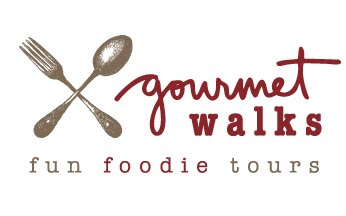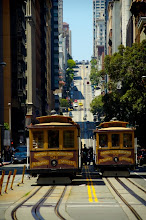 This past Superbowl Sunday, rather than tending a chili and shopping for beer, I took my tour guides to a chocolate cooking class with Richard Festen of Baking Arts. Chocolate thermometers in hand, we stirred and dipped and re-heated and stirred again to create some delectable dark chocolate truffles and cocoa logs. Richard teaches his baking classes out of a small and stylish kitchen/loft in SOMA and keeps the groups small enough so you'll get plenty of attention and experience. Lucky for us, Richard had recently studied at Chicago's Callebaut Chocolate Academy to further expand his chocolate offerings. Other classes include pies, croissants, eclairs, cream puffs and the ubiquitous French Macaron. Take one look at his web site and the fabulous cakes he has created and you'll know you are in good hands.
This past Superbowl Sunday, rather than tending a chili and shopping for beer, I took my tour guides to a chocolate cooking class with Richard Festen of Baking Arts. Chocolate thermometers in hand, we stirred and dipped and re-heated and stirred again to create some delectable dark chocolate truffles and cocoa logs. Richard teaches his baking classes out of a small and stylish kitchen/loft in SOMA and keeps the groups small enough so you'll get plenty of attention and experience. Lucky for us, Richard had recently studied at Chicago's Callebaut Chocolate Academy to further expand his chocolate offerings. Other classes include pies, croissants, eclairs, cream puffs and the ubiquitous French Macaron. Take one look at his web site and the fabulous cakes he has created and you'll know you are in good hands.It's been said that the Type A personality is a pre-requisite for mastering the precise art of baking. I hire my tour guides for their effervescent enthusiasm for chocolate and their vibrant personalities - not necessarily for their patience. As we tried to get our bowls of chocolate to that magical sweet spot of 88 to 91 degrees, mumbled curses louder and louder. A chocolate thermometer reads in 1 degree increments since a small difference in degree makes a big difference in the final result. Why not just melt chocolate and pop a strawberry in it, like you do with most home baking recipes? We learned by experience that untempered chocolate will bloom quickly and lack shine. It will be messy to serve and won't snap sharply the way a good chocolate bar does. Most large scale chocolate producers have tempering machines, but for the home baker, there is no choice but to learn how to temper.
When the chocolate at last reached the right temperature, we took our balls of ganache and dipped them in with a chocolate dipping fork, taking care to tap the bowl and remove the excess so our truffles did not develop "hips." After dipping, we rolled each truffle in shaved dark chocolate or white chocolate, an easy way to hide mistakes for the amateur chocolate maker. We used the same method for cocoa logs, also rolling each in powdered sugar and then laying to rest. We found that after making just about 4 or 5 chocolates, the temperature dipped too low and we were back to re-heating and stirring and tempering once more.
As chocolate tour guides, we are always curious about the type of chocolate bakers choose to use. For Richard, it is Guittard's 72% chocolate wafers. Although he had made the ganache in advance for us (since it needs a day to rest), he demonstrated his method at the end and let us try our hands at piping what would become the cocoa logs. Again, precision was key. Richard used his chocolate thermometer and his digital scale to ensure that the ganache was smooth, creamy and lump-free. That didn't stop us from pushing too hard with the piping or not hard enough so that our logs resembled lumpy caterpillars.
In the end we all graduated from Chocolate 1 with a box of slightly imperfect chocolates to take home and show off. But to bring to a Superbowl Party? Doubtful, we know by now not to waste fine chocolate! We also previewed the techniques learned in Chocolate 2 and Chocolate 3, from molding chocolate to using intricate transfer sheets to decorate the tops. Something to aspire to, but for now we will return to talking about chocolate and eating it as Gourmet Walks tour guides - letting the masters do the hard work.
Recipe: Baking Arts Cocoa Logs
yields approximately 30 pieces
2 oz bittersweet chocolate 64%, chopped
3 oz semisweet chocolate 55%, chopped
3 1/4 oz heavy cream (6 T)
1/2 oz light corn syrup (2 tsp)
1/2 oz butter, unsalted, room temp (1 T)
1 lb chocolate, tempered
2 cups powdered sugar, sifted
For the ganache: Place chopped chocolate in a medium sized bowl. Set aside.
Bring cream and corn syrup just to the boil while stirring. Pour over chopped chocolate and allow to sit for 2 minutes. Slowly stir with a whisk to begin creating the emulsion. Stir thoroughly to ensure the ganache is well mixed and emulsified.
Check the temperature. When the ganache reaches 95F, mix in the softened butter, stirring well. Let the ganache cool at room temperature undisturbed for about an hour or until it has cooled to below 74F.
Line a baking sheet with parchment. Scrape ganache into a large piping bag fitted with an Ateco #806 round tip. Pipe out even parallel lines of ganache. Set aside to dry overnight at room temperature. Cut into 1 1/4 inch lengths with a paring knife. Dip in tempered chocolate and roll in powdered sugar. Allow chocolate to set before storing cocoa logs at cool room temperature.

